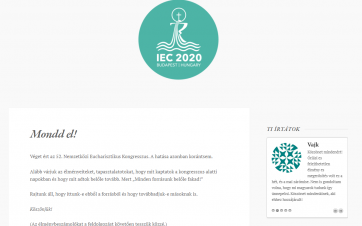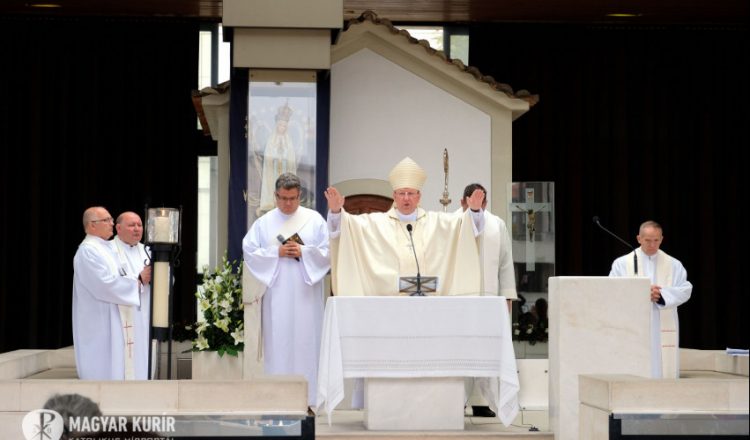
A national pilgrimage to Fatima in preparation for the Eucharistic Congress

Ferenc Palánki, diocesan bishop of Debrecen-Nyíregyháza, during holy mass solemnly offered the 2020 International Eucharistic Congress to the Blessed Mother, on October 28, in Fatima, in the chapel of the apparitions.
At their spring meeting the Hungarian Catholic Bishops’ Conference encouraged the faithful to pray for our country in the coming October in Fatima at the Hungarian stations of the cross, and for the success of the 2020 International Eucharistic Congress in Budapest. Mission Tours Travel Agency organised a national pilgrimage to further this goal, held between October 25 and 29th and travelled to the shrine in Portugal. One hundred and sixty compatriots visited the sites where the Blessed Mother appeared to the three shepherd children in 1917. The pilgrims heard mass, and prayed for their loved ones, their nation, and the success of the congress. The spiritual leader of the pilgrimage was Ferenc Palánki, diocesan bishop of Debrecen-Nyíregyháza, who during holy mass solemnly offered next year’s International Eucharistic Congress to the Blessed Mother, in the chapel of the apparitions.
The Blessed Mother appeared to three illiterate shepherd children at this place. She gave them a message for all of mankind. Through them She asked the world for reparation and conversion. Mary visited the children six times, from May of 1917 to October. The Marian apparitions were preceded by three angelic apparitions in 1916, followed by further angelic apparitions. Many did not believe the little visionaries, and wanted to use violent means to get them to confess to lying. The three children, Lúcia Santos and her cousins, Jacinta Marto and Francisco Marto foretold of the miracle of the sun, witnessed by seventy thousand people gathered in Fatima and the area; the sun shone in the colours of the rainbow and drove towards the ground and rose again. This was seen by many not gathered as spectators but simply working in the fields, and among non-religious participants gathered for the spectacle. The church finally recognised that the miracle of the sun was a supernatural divine sign and that God had spoken through the Blessed Virgin in Fatima. A statue of Mary was made based upon the description of the apparition by the children, it stands today on the site of the apparition in the sanctuary in the chapel of the apparitions. Here bishop Ferenc Palánki led the Hungarian pilgrims in offering to the Blessed Mother the 2020 Budapest International Eucharistic Congress.
The statue, based on the description of the visionaries, was first taken to Lisbon and then Spanish parishes. An exceptional number of conversions happened in its presence, and so a copy was made so that one could be present in the sanctuary and the other could travel the world. Between 1947 and 1957 alone this statue travelled around the earth nine times and three hundred million people prayed before it.
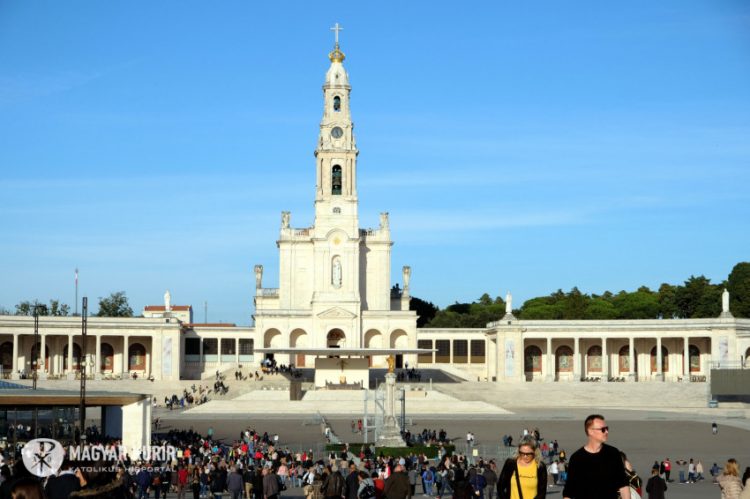
It was unable to enter socialist countries at the time unfortunately, but after the change in regimes, the bishop of Fatima approached the then head of the Hungarian Catholic Bishops Conference, István Seregély, archbishop of Eger, and told him what a blessing it would be if the travelling Fatima statue could visit our homeland. The archbishop welcomed the idea of the devotional statue visiting Hungary.
June the 10th is Portugal’s national holiday, and had been a day for children’s pilgrimage to Fatima for many years. Thus, archbishop István Seregély, the bishop of Fatima, and Lajos Kondor Verbite religious, who was the postulator of the canonisation of the two shepherd children Jacinta and Francisco, had the idea that Hungarian children should go on pilgrimage to Fatima and return with the travelling Fatima statue. In June 1994 a Malév charter flight took 120 children to the Portuguese shrine, who then brought back the statue of the Blessed Mother. The statue visited one hundred churches in one hundred days, where the faithful prayed before it and asked for Mary’s intercession.
In 2006 the Hungarian Bishops Conference announced a year of prayer for spiritual renewal. Cardinal Péter Erdő, primate, archbishop of Esztergom-Budapest celebrated mass at the open-air altar on Margaret Island on January 15th, the feast of St. Margaret, and opened the national year of prayer. In October of 2006, the supplication of our first holy king was repeated in Fatima, and our nation was offered under the protection of Mary.
It is in the tradition of these antecedents that almost 160 pilgrims, led by bishop Ferenc Palánki, travelled to Fatima to ask for the protection of Mary for next year’s congress. They walked the Hungarian stations of the cross, named after Cardinal Joseph Mindszenty, heard holy mass in the St. Stephen chapel at the end of the stations, they prayed the rosary every evening in the chapel of the apparitions and the stations of the cross. There was an evening when one decade was prayed by the Hungarians before a crowd of tens of thousands of pilgrims, and there was another occasion when Hungarians carried the statue of the Virgin Mother on their shoulders.
At the beginning of every prayer, Ferenc Palánki stressed that the 160 pilgrims were taking our entire nation before the feet of the Virgin Mother. The bishop stated that it is only from Jesus that we gain grace, and we can do this most effectively in the presence of Mary.
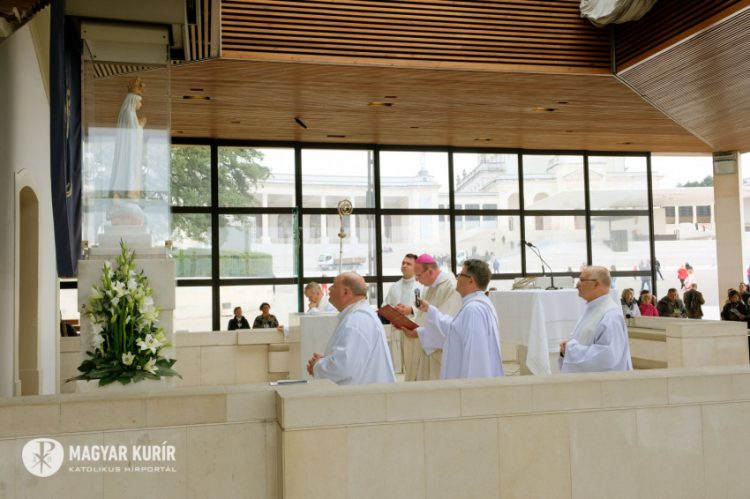
In his homily on October 28th the bishop continued his earlier thought and spoke of how Mary had not only conceived the Son of God in her womb, but also in her heart. The Word wants to incarnate Himself in every person's heart, and live in everyone. Jesus is among us in the Blessed Sacrament, He wants to work in us, and through us in the world. It is up to us to accept Him in our hearts. Mary was able to cooperate with the grace of God. This continuum began with her and continues in the body of the Church. We are the Church, and so we must ask the Virgin Mother to help us to be obedient as she was at that special moment. To prevent any barriers to the flow of grace in us, that the divine Word can work effectively in us. Mary is the eucharistic woman, who dressed Herself in Christ, and is an example for us, helping us to put on Christ, to welcome the Lord in the Eucharist, and thus into our lives.
Following the homily bishop Ferenc Palánki and the concelebrating priests knelt before the Marian statue in the sanctuary and prayed the prayer written by Cardinal Péter Erdő asking for the patronage of the Blessed Virgin Mary.
The words of the prayer can be found by clicking on the link here.
At the open section of the chapel there were pilgrims from every part of the world, praying and watching curiously. One asked, “What’s happening, what did the bishop pray?” I began to explain, and when I translated the name of the International Eucharistic Conference, the curious pilgrim smiled and said, “I know, I know, it will be next year in Budapest. I plan to go… You are Hungarian?”, he asked in amazement.
These moments reinforced in me the always unique experience and recognition of how colourful and so universal our Church still is. Regardless of how many languages the mass is said in I always know at what point they are at in the liturgy, and the readings are the same in all the Catholic churches, as is the Gospel on any given day of the year. The Virgin Mother of Fatima invites all people to be her guests and for all nations to reconcile. This seems to have become a reality in Fatima. As we walked along the Hungarian Calvary we met faithful from every part of the world, from all of the continents. A defining characteristic was the mutual love and attention to each other given by all. Mary gives her patronage to all, it is therefore worthwhile to ask for Her intercession at her Son, Jesus Christ.
The video recording of the film can be found HERE.
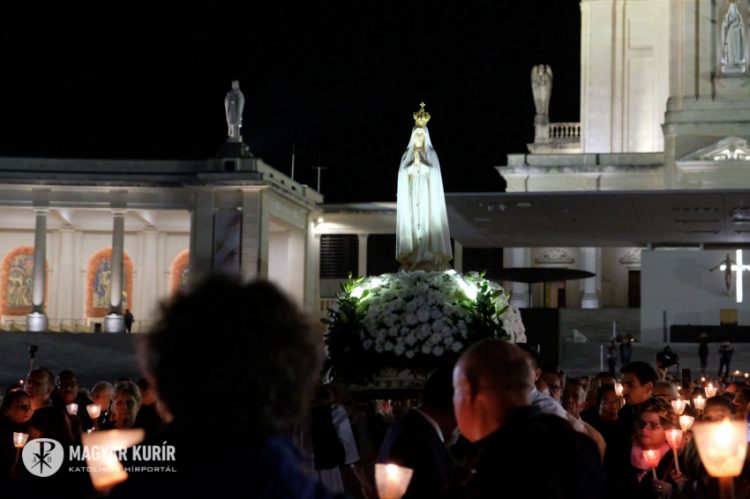
Article and photograph by László Bókay/Magyar Kurir




